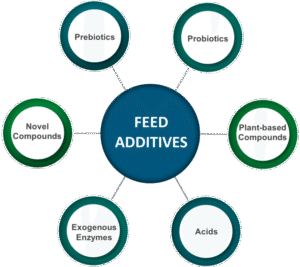Amino acids are characterised by the two characteristic functional
groups in the molecule, as indicated by their nomenclature, by the
amino group NH2 and the carboxyl group COOH.
Amino acids occur exclusively as structural protein units in which the
amino group is bound to the α-position of the carboxylic acid group
(carboxyl group). Chemically amino groups can bind in other positions,
however only α-amino acids are relevant for animal nutrition.
Glycine is the simplest representative of an amino acid with two
hydrogen atoms attached to the C atom (Figure 4). In all other
amino acids which are found in protein, an aliphatic or aromatic
substituent (=R) is attached to the carbon atom, in addition to the
amino group.
There are two different types of amino acids, the so-called optically
active isomers. Optically active isomers differ with respect
to the spatial arrangement of the four bonds on the carbon atom.
This gives rise to the two forms termed the L-form and D-form.
These forms exist as mirror images of each other in the same
way as the right hand is to the left hand (Figure 4). Apart from
differences in the physiological efficacy in animal organisms, the
chemical and physical characteristics of optical isomers are the
same except for one property. They differ in the optical rotation of
polarised light, hence the term optical isomers.
L-amino acids
D-amino acids
Figure 4 – General structure of L- D- isomers
Amino acids found in proteins belong to the L-series. If an animal
is supplied with amino acids in both the D- and L-forms (that is
a 50:50 mixture of L- and D-amino acids, also called a “racemic
mixture”) then the D-form has to be converted into the L-amino
acid before it can participate in metabolism. This can be achieved
by deamination to the keto form and subsequent amination into Lamino
acid. This conversion process is dependent on the animal
species and takes place for individual amino acids with varying
efficiency. In the case of Methionine, this conversion is so effective
that from a nutritional point of view, separation of the D and
L- isomers is not necessary.
2-hydroxy-4-(methylthio) butanoic acid (HMTBa) is a naturally occurring
hydroxy analogue of methionine that can be converted into
L-methionine in the tissues for use in protein synthesis. As a chemically
synthesized feed supplement HMTBa occurs in a racemic
mixture of D- and L- isomers, similar to synthetic methionine. The
difference between HMTBa and methionine is that with HMTBa
there is a hydroxyl group in place of the amino group at the second
carbon (Figure 5). This difference allows classification of the former
as an organic acid whereas the latter is an amino acid.
About 20 different amino acids have been identified following
direct hydrolysis of common nutritional feed proteins. Based on
chemical principles amino acids can be divided into three main
categories, the neutral, acidic and basic amino acids (Table 2).
This classification is based on the different types of substituents
(R) which are present on the carbon atom in addition to the amino
group. Acidic amino acids possess a second carboxyl group in
the substituent R position, whilst the basic amino acids have an
additional basic group.
Table 2 – Classification of amino acids according to their chemical characteristics
-Acidic amino acids
Asparaginic acid
Glutamic acid
-Neutral amino acids
Alanine
Glutamic acid Asparagine
Glutamine
Hydroxyproline
Isoleucine
Leucine
Methionine
Phenylalanine
Proline
Serine
Tryptophan
Tyrosine
Valine
Basic amino acids
Arginine
Hystidine
Thank you for reading. Don't forget to subscribe & share!









